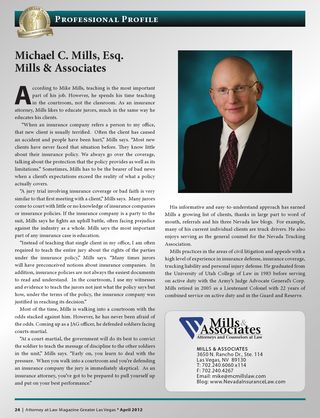 In the case of Bish v. Guaranty Nat’l Ins. Co., 109 Nev. 133; 848 P.2d 1057; 1993 Nev. LEXIS 26, the Nevada Supreme Court examined the question of what is an “occurrence”. The facts are these.
In the case of Bish v. Guaranty Nat’l Ins. Co., 109 Nev. 133; 848 P.2d 1057; 1993 Nev. LEXIS 26, the Nevada Supreme Court examined the question of what is an “occurrence”. The facts are these.
Four-year-old Christina Rose was playing on the sidewalk near the driveway of the neighbor, Ms. Alderson. At that moment, Ms. Alderson chose to back her vehicle out of the drive. Ms. Alderson accidently backed over the child. A neighbor saw the accident and screamed. Ms. Alderson put her vehicle in drive and accidently drove over Christina Rose a second time. Christina Rose suffered serious injuries.
Christina Rose’s mother sued Ms. Alderson alleging that not only had Ms. Alderson been negligent, but that her negligence amounted to two “occurrences”. The advantages from such an argument are pretty clear. Liability policies have “each occurrence” limits. By arguing that there had been two “occurrences”, Christina Rose’s mother was seeking to double the amount of liability coverage available to her daughter.
Christina’s Mother brought a declaratory relief action against Martha Alderson and Guaranty National Insurance Company, Ms. Alderson’s auto insurance. The District Court found on Summary Judgment that there was but one “occurrence”. The Nevada Supreme Court was asked to review.
The Nevada Supreme Court acknowledged that while there was a divide between the jurisdictions, the vast majority of jurisdictions adopted the “causal” approach. The Court explained just how such an analysis is to be done. The Court said:
the inquiry is focused on whether there was one or more than one cause which resulted in all of the injuries or damages. See, e.g., Olsen v. Moore, 56 Wis. 2d 340, 202 N.W.2d 236 (Wis. 1972); see also Michael P. Sullivan, Annotation, What Constitutes Single Accident or Occurrence Within Liability Policy Limiting Insurer’s Liability to a Specified Amount Per Accident or Occurrence, 64 A.L.R. 4th 668 (1988).
Looking at other jurisdictions that used the “causal” approach, the Nevada Supreme Court pointed to Welter v. Singer, 126 Wis. 2d 242, 376 N.W.2d 84 (Wis. Ct. App. 1985) as being persuasive. After comparing the facts of the two cases, the Court said:
The Wisconsin Court of Appeals affirmed. The court emphasized that the focus of the inquiry should not be on the number, magnitude or time of the injuries, but rather on the cause or causes of the injury: “‘As long as the injuries stem from one proximate cause there is a single occurrence.'”
Applying the “causal” approach to the facts of this case, the Nevada Supreme Court then concluded:
In summary, all of the child’s injuries are attributable to one proximate, uninterrupted and continuing cause: Alderson’s negligence. Accordingly, respondent is liable for just one accident.
If you have questions about Nevada Coverage or Insurance Law, please contact Mike Mills at 702.240.6060×114 or email him at mmills@blwmlawfirm.com.
 Follow
Follow Email
Email


